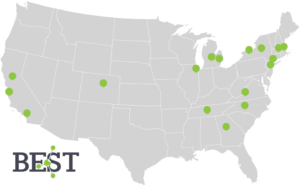
This post could easily start out as an ode to ’90s alternative music (of which I’m a huge fan). That new and totally different sound (a la Pearl Jam, Smashing Pumpkins, Soundgarden, Nirvana, etc.) in the 1990s eventually made its way into the mainstream as it gained popularity. (I have to say that I got a shock when I recently heard some Pearl Jam on “classic rock” radio stations. But I digress…)
Why isn’t the same true for science career paths? Science careers outside of academia are still referred to as “alternative.” In a previous post, I highlighted statistics from a 2012 NIH report that found that only 20% of recent life sciences Ph.D.’s go on to become faculty members1. That means that 80% of recent life sciences Ph.D.’s took the “alternative” path. It seems like the academic path could now be viewed as the alternative to the mainstream, but somehow there’s an underlying stigma associated with straying from a path which few can travel down successfully.
Many Ph.D’s are starting down the academic route by doing a postdoc and then remaining in a holding pattern, waiting for faculty positions to open up. An idea to discourage that is the newly proposed “postdoc tax” that would charge PIs $1000 a year per postdoc they employ, providing funding for programs on mentoring and career education2. The panel that proposed the fee also suggested several ideas for encouraging postdocs to move on and for PIs to create more permanent staff scientist positions. These ideas include capping the number of years that a postdoc can be supported on a grant, increasing the postdoc starting salary, and increasing the number of fellowship/career development grant awards2,3.
These measures send a strong message to look outside of the traditional faculty member role for permanent career options. But many students and postdocs are still keeping their eyes on the prize of a faculty job. At a Gordon Research Seminar career panel that I organized in 2016, we had representatives from industry, government, a small liberal arts college, and large research universities. Despite the diversity in sectors represented, more than half of the questions from the audience of postdocs and grad students were directed toward how to become a successful faculty member.
I recently gave a career talk back at my grad school alma mater through the Graduate Women in Science group. To drum up interest, I entitled my talk, “Tales from the Other Side: My Experience Working in Industry.” I was happy that the turnout included grad students, postdocs, and also faculty members. We had a great discussion about the variety of roles that a scientist could take in an industry setting. Then, my grad school advisor, in his ever-present quest to collect data, polled the audience to take a vote on what careers they were considering. While his intentions were genuinely good, I noticed that, while the faculty members were very interested in the data, many of the students and postdocs were reluctant to raise their hands when he asked about careers other than academia. Many of them, if not most of them, had an interest in an academic career, in addition to the “alternatives.”
Perhaps the issue stems from a lack of awareness. I was excited to hear from University of Rochester faculty and students about a new NIH-sponsored program that encourages learning about and exploring careers other than academia. They call it URBEST (University of Rochester Broadening Experience in Scientific Training). I had never heard of such a program before, so I did some homework. BEST (Broadening Experience in Scientific Training) is an NIH Common Fund Program that has the goal of developing and implementing “Career Development Experiments” that are designed to help grad students and postdocs to learn how their training can prepare them for a variety of scientific careers4. There are currently 17 institutions that have a BEST program4,5, and each has a different approach to achieve the goal of broadening the applicability of graduate school and postdoctoral training to many different careers. This is certainly a positive step toward creating awareness about the broad applicability of skills learned in the biomedical sciences. Another critical piece of the puzzle is PI/advisor buy-in. Faculty members’ awareness of career options will help them to better mentor their trainees. Encouragement and support for seeking these opportunities, especially in the form of time outside the lab, will facilitate grad students’ and postdocs’ journeys down non-academic paths.
References
1 National Institutes of Health (2012) Biomedical Research Workforce Working Group Report (National Institutes of Health, Bethesda, MD).
2 Price, M. (2018) Panel calls for a postdoc tax and other measures to help biomedical scientists find jobs. Science, doi:10.1126/science.aat8708
3 National Academies of Science Engineering and Medicine (2018) The Next Generation of Biomedical and Behavioral Sciences Researchers: Breaking Through
4National Institutes of Health BEST webpage: http://www.nihbest.org/
5National Institutes of Health Office of Strategic Coordination – The Common Fund. Funded Research webpage: http://commonfund.nih.gov/workforce/fundedresearch
Updated April 11, 2024 to correct broken links.

